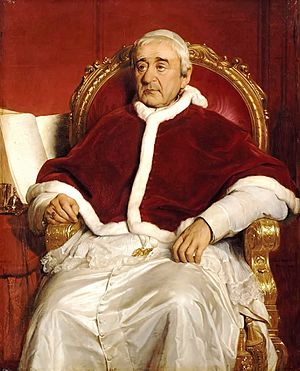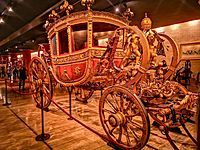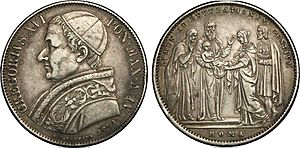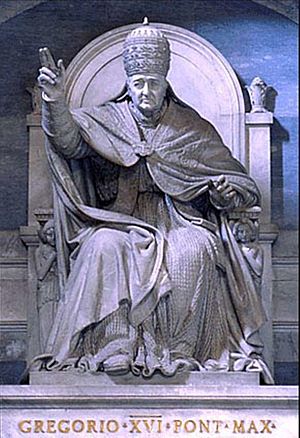Pope Gregory XVI facts for kids
Quick facts for kids Pope Gregory XVI |
|
|---|---|
| Bishop of Rome | |

Portrait by Paul Delaroche, 1844, Palace of Versailles
|
|
| Church | Catholic Church |
| Papacy began | 2 February 1831 |
| Papacy ended | 1 June 1846 |
| Predecessor | Pius VIII |
| Successor | Pius IX |
| Orders | |
| Ordination | 1787 |
| Consecration | 6 February 1831 by Bartolomeo Pacca |
| Created Cardinal | 13 March 1826 |
| Personal details | |
| Birth name | Bartolomeo Alberto Cappellari |
| Born | 18 September 1765 Belluno, Republic of Venice |
| Died | 1 June 1846 (aged 80) Rome, Papal States |
| Previous post |
|
| Signature | |
| Coat of arms |  |
| Other Popes named Gregory | |
Pope Gregory XVI (Latin: Gregorius XVI; Italian: Gregorio XVI) was born Bartolomeo Alberto Cappellari on 18 September 1765. He was the leader of the Catholic Church and the ruler of the Papal States from 2 February 1831 until his death on 1 June 1846. When he joined a religious order, he took the name Mauro.
Gregory XVI was very traditional and conservative. He did not support democratic changes or modern ideas in the Papal States or in Europe. He saw these changes as part of a revolutionary movement. He wanted to make the Pope's religious and political power stronger. This idea is called ultramontanism. In a special letter called Mirari vos, he said it was "false and absurd" to believe everyone should have freedom of conscience. He also encouraged missionary work around the world and spoke out against the slave trade.
He was the most recent pope to use the name "Gregory". He was also the most recent pope who was not a bishop when he was chosen. Until Pope Francis in 2013, he was the most recent pope who had been a priest from a religious order.
Contents
Biography
Early life and becoming a monk
Bartolomeo Alberto Cappellari was born in Belluno, which was part of the Republic of Venice, on 18 September 1765. His family was a lower noble family from Italy. When he was 18, Bartolomeo joined the Camaldolese order. This order is part of the Benedictine monastic family. He entered the Monastery of San Michele near Venice.
He became a priest in 1787. As a Camaldolese monk, Cappellari quickly became known for his knowledge of theology and languages. At 22, he began teaching philosophy and theology at San Michele.
In 1790, at 25, he was chosen to check books for his order and for the Holy Office in Venice. In 1795, he moved to Rome. In 1799, he wrote a book called II Trionfo della Santa Sede ("The Triumph of the Holy See"). This book argued against a group called the Jansenists. The book was very popular and was translated into several languages.
In 1800, he joined the Academy of the Catholic Religion. This group was started by Pope Pius VII. He wrote many papers on religious and philosophical topics for them. In 1805, at age 40, he became the abbot (leader) of the Monastery of San Gregorio in Rome.
When Napoleon's army took Rome in 1809, Cappellari went back to Murano. He taught at the Monastery of St. Michele. After Napoleon was defeated, the Congress of Vienna gave the Papal States back their control over central Italy. Cappellari was called back to Rome. He became the main leader of the Camaldolese Order. He also became an advisor to the Inquisition. Later, he became the head of the Congregation of Propaganda Fide. This group managed all missionary work outside the Spanish Empire. He was offered to become a bishop twice, but he said no both times.
Becoming a Cardinal

On 21 March 1825, Pope Leo XII secretly made Cappellari a cardinal. This was announced publicly on 13 March 1826. Soon after, he helped make an agreement to protect the rights of Catholics in the Low Countries. He also helped make peace for Armenian Catholics with the Ottoman Empire. He spoke out against Polish revolutionaries. He believed they were trying to weaken the Russian Tsar Nicholas I.
Cappellari had never left Italy. He knew Venice and Rome very well. He spoke Italian and Latin perfectly, but no other European languages. He also did not understand European politics very well. However, he was good at Armenian. A book of works translated into Armenian was dedicated to him in 1827.
Pontificate
Papal election
| Papal styles of Pope Gregory XVI |
|
|---|---|
 |
|
| Reference style | His Holiness |
| Spoken style | Your Holiness |
| Religious style | Holy Father |
| Posthumous style | None |
On 2 February 1831, after a 50-day meeting called a conclave, Cappellari was chosen to be the next Pope. This was a surprise choice. The cardinal who was most likely to become pope, Giacomo Giustiniani, was blocked by King Ferdinand VII of Spain. Then, the other two main candidates could not agree. The cardinals decided to choose Cappellari. It took 83 votes for him to get the needed two-thirds majority.
When he was chosen, Cardinal Cappellari was not yet a bishop. He is the most recent person to be elected pope before becoming a bishop. He was made a bishop by Bartolomeo Pacca.
He chose the name Gregory XVI because he had been the abbot of the Monastery of San Gregorio for over 20 years. He also chose it to honor Pope Gregory XV, who started the Congregation for the Propagation of the Faith. The Monastery of San Gregorio was the same place where Pope Gregory I sent missionaries to England in 596.
Actions as Pope
The July Revolution in 1830 had just removed the old royal family in France. One of the first things the new French government did was take over Ancona. This caused a lot of trouble and political unrest in Italy, especially in the Papal States. During the fighting, Austrian soldiers had to be called in many times. They fought against republicans who wore red shirts.
The government of the Papal States was very conservative. They delayed the changes they had promised after some bombings and assassination attempts. When Luigi Lambruschini replaced Tommaso Bernetti as the Pope's main secretary in 1836, it did not make things better.
In the northern areas, the leaders of the revolt were middle-class people. They were against how inefficient the government was.
Governing the Papal States
Pope Gregory XVI and Cardinal Lambruschini did not like new technologies. They opposed things like gas lighting and railways. They believed these would help businesses and make the middle class stronger. They thought this would lead to demands for more freedom. They feared this would weaken the Pope's power over central Italy. Gregory XVI even banned railways in the Papal States. He called them chemins d'enfer, which means "roads to hell". This was a play on the French word for railway, chemin de fer, meaning "iron road".
There were many revolts in the Papal States. These included Viterbo in 1836, parts of the Legations in 1840, Ravenna in 1843, and Rimini in 1845. After these revolts, many people were executed. Others were given harsh prison sentences or sent away from their homes. But these actions did not stop the unrest.
Gregory XVI spent a lot of money on building projects and defenses. He had a monument built for Pope Leo XII in 1837. He also supported scholars like Angelo Mai and Gaetano Moroni. However, all this spending made the Papal States' finances much weaker.
Condemnation of the slave trade
Pope Gregory XVI strongly condemned the slave trade. He issued a special letter called In supremo apostolatus in 1839. In this letter, he called the slave trade a terrible crime. He urged all Catholics to work against it. He believed that all people, regardless of their race, had the right to freedom. This was an important step for the Church in fighting against slavery.
Other activities
Important letters
Pope Gregory XVI wrote several important letters called encyclicals.
- Sollicitudo ecclesiarum (1831) said that if a government changed, the Church would talk with the new government about appointing bishops.
- Mirari Vos (1832) was about liberalism and religious indifference.
- Singulari Nos (1834) was about the ideas of Hugues Félicité Robert de Lamennais.
New saints and blessed people
During his time as Pope, Gregory XVI made Veronica Giuliani a saint. Five people were made saints, including Alphonsus Liguori. Thirty-three people were declared Blessed. Many new religious orders were started or supported. Also, people's devotion to the Blessed Virgin Mary grew stronger.
New Cardinals
The Pope created 75 new cardinals in 24 different meetings. He secretly named 35 cardinals, including Giovanni Maria Mastai-Ferretti, who later became Pope Pius IX. He also secretly named six other cardinals whose names were never revealed before he died. This meant their appointments were canceled.
Death and burial
On 20 May 1846, Pope Gregory XVI began to feel unwell. A few days later, he got a skin infection on his face. At first, it did not seem serious. But on 31 May, he suddenly became very weak. It was clear he was dying.
Gregory XVI died on 1 June 1846 at 9:15 AM. He was 80 years old. That morning, he received the Extreme Unction, a special prayer for the sick. After his funeral, he was buried in Saint Peter's Basilica.
See also
 In Spanish: Gregorio XVI para niños
In Spanish: Gregorio XVI para niños
- Cardinals created by Gregory XVI
- List of encyclicals of Pope Gregory XVI
- List of popes



